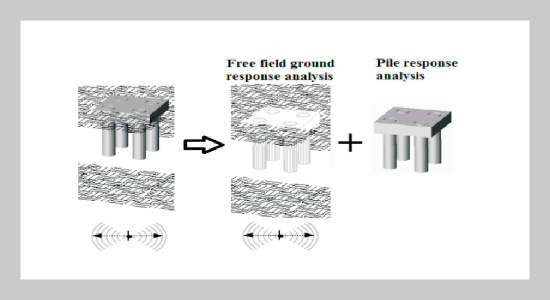REFERENCES
- [1] Honjo, Y., “Comprehensive Design Codes Development in Japan: Geo-Code 21 ver. 3 and Code Platform ver. 1,” LSD2003: International Workshop on LimitState Design in Geotechnical Engineering Practice (2003).
- [2] Chang, D. W., Lee, S. H. and Chin, C. T., “Wave Equation Analyses for Seismic Grouped Pile Response,” Procds., The 15th International Conference on Soil Mechanics and Geotechnical Engr., Istanbul, Turkey, pp. 859�862 (2001).
- [3] Chang, D. W. and Lin, B. S., “Wave Equation Analyses on Seismic Responses of Grouped Piles,” Procds., The 12th Asian Regional Conference on Soil Mechanics and Geotechnical Engineering, Singapore, pp. 581�586 (2003).
- [4] Chang, D. W. and Lin, B. S., “EQWEAP~A Simplified Procedure to Analyze Dynamic Pile-Soil Interaction with Soil Liquefaction Concerns,” Procds., The 2nd Taiwan-Japan Joint Workshop on Geotechnical Hazards from Large Earthquake and Heavy Rainfall, Nagaoka, Japan, pp. 155�162 (2006).
- [5] Chang, D. W., Lin, B. S. and Cheng, S. H., “Dynamic Pile Behaviors Affected by Liquefaction from EQWEAP Analysis,” Procds., The 4th Int. Conf. on Earthquake Geotechnical Engineering, Thessaloniki, Greece, ID: 1336 (2007a).
- [6] Chang, D. W., Lin, B. S. and Cheng, S. H., “Wave Equation Analyses to Evaluate Pile Damage Subjected to Soil Liquefaction and Lateral Spreads,” Procds., The 13th Asian Regional Conference on Soil Mechanics and Geotechnical Engineering, Kolkata, India (2007b).
- [7] Chang, D. W., Lin, B. S., Yen, C. H. and Cheng, S. H. “FD Solutions for Static and Dynamic Winkler Models with Lateral Spread Induced Earth Pressures on Piles,” Procds., Geotechnical Earthquake Engineering and Soil Dynamics IV, Sacramento, CA, US (2008a).
- [8] Chang, D. W., Cheng, S. H. and Lin, B. S., “Discrete Wave Equation Analysis for Seismic Responses of Piles,” Procds., Stress Wave 2008 - 8th International Conference on the Application of Stress Wave Theory to Piles, Lisbon, Portugal, September, pp. 285�292 (2008b).
- [9] Chang, D. W., Cheng, S. H., Chang, S. L., Lee, H. T., Sheu, S. H. and Liu, K. F., “Alternative Modeling on Liquefaction Affected Pile Response Using EQWEAP Analysis,” Procds., The 3rd Taiwan-Japan Joint Workshop on Geotechnical Natural Hazards, Keelung, Taiwan, pp. 185�197 (2008c).
- [10] Japan Road Association, Specification for Highway Bridges, Part V, Seismic Design (1996).
- [11] Finn, W. D. L., Lee, K. W. and Martin, G. R., “An Effective Stress Model for Liquefaction,” Journal of the Geotechnical Engineering Division, ASCE, Vol. 103, No. SM7, pp. 657�692 (1977).
- [12] Seed, H. B. and Idriss, I. M., “Soil Moduli and Damping Factors for Dynamic Response Analysis,” Report No. EERC 75-29, Earthquake Engineering Research Center (University of California, Berkeley, California) (1970).
- [13] Chang, D. W, Cheng, S. H. and Yang, C. L., “OneDimensional Wave Equation Analyses for Pile Responses due Seismic Horizontal Ground Motions,” Soils and Foundations (under review) (2013).
- [14] Kunnath, S. K. and Reinhorn, A. M., “Inelastic ThreeDimensional Response Analysis of RC Buildings (IDARC-3D) Part I - Modelling,” Technical Report NCEER-89-0009, National Center for Earthquake Engineering Research, SUNY/Buffalo (1989).
- [15] Kramer, S. L., “Performance � Based Earthquake Engineering: Opportunities and Implications for Geotechnical Engineering Practice,” Procds., Geotechnical Earthquake Engineering and Soil Dynamics IV, Sacramento, CA, US (2008).
- [16] Shin, H. S., Numerical Modelling of a Bridge System & Its Application for Performance-Based Earthquake Engineering, PhD Thesis, Dept. of Civil & Environmental Engineering, University of Washington (2007).
- [17] Chen, C. H., Yang, H. S., Hwang, J. H., Lee, W. F. and Wang, C. H., “Study on Seismic Performance Design for Foundations of Transportation System,” Sino-Geotechnics, Vol. 109, pp. 73�82 (2006).
- [18] Cheng, C. T., Uncertainty Analysis and Deaggregation of Seismic Hazard in Taiwan, PhD Thesis, Dept. of Earth Science and Inst. of Geophysics, National Central University, Chung-Li, Taiwan (2002).
- [19] Chang, D. W., Lin, B. S. and Cheng, S. H. “Lateral Load Distributions on Grouped Piles from Dynamic Pile-to-Pile Interaction Factors,” International Journal for Numerical and Analytical Methods in Geomechanics, Vol. 33, No. 2, pp. 173�191 (2009).
















